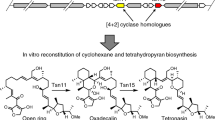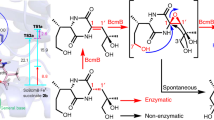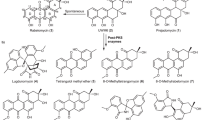Abstract
Polycyclic polyether natural products have fascinated chemists and biologists alike owing to their useful biological activity, highly complex structure and intriguing biosynthetic mechanisms. Following the original proposal for the polyepoxide origin of lasalocid and isolasalocid1 and the experimental determination of the origins of the oxygen and carbon atoms of both lasalocid and monensin, a unified stereochemical model for the biosynthesis of polyether ionophore antibiotics was proposed2. The model was based on a cascade of nucleophilic ring closures of postulated polyepoxide substrates generated by stereospecific oxidation of all-trans polyene polyketide intermediates2. Shortly thereafter, a related model was proposed for the biogenesis of marine ladder toxins, involving a series of nominally disfavoured anti-Baldwin, endo-tet epoxide-ring-opening reactions3,4,5. Recently, we identified Lsd19 from the Streptomyces lasaliensis gene cluster as the epoxide hydrolase responsible for the epoxide-opening cyclization of bisepoxyprelasalocid A6 to form lasalocid A7,8. Here we report the X-ray crystal structure of Lsd19 in complex with its substrate and product analogue9 to provide the first atomic structure—to our knowledge—of a natural enzyme capable of catalysing the disfavoured epoxide-opening cyclic ether formation. On the basis of our structural and computational studies, we propose a general mechanism for the enzymatic catalysis of polyether natural product biosynthesis.
This is a preview of subscription content, access via your institution
Access options
Subscribe to this journal
Receive 51 print issues and online access
$199.00 per year
only $3.90 per issue
Buy this article
- Purchase on Springer Link
- Instant access to full article PDF
Prices may be subject to local taxes which are calculated during checkout



Similar content being viewed by others
References
Westley, J. W., Blount, J. F., Evans, R. H., Jr, Stempel, A. & Berger, J. Biosynthesis of lasalocid. II. X-ray analysis of a naturally occurring isomer of lasalocid A. J. Antibiot. (Tokyo) 27, 597–604 (1974)
Cane, D. E., Celmer, W. D. & Westley, J. W. Unified stereochemical model of polyether antibiotic structure and biogenesis. J. Am. Chem. Soc. 105, 3594–3600 (1983)
Nakanishi, K. The chemistry of brevetoxins: a review. Toxicon 23, 473–479 (1985)
Baldwin, J. E. Rules for ring closure. J. Chem. Soc. Chem. Comm. 734–736. (1976)
Gilmore, K. & Alabugin, I. V. Cyclizations of alkynes: revisiting Baldwin’s rules for ring closure. Chem. Rev. 111, 6513–6556 (2011)
Shichijo, Y. et al. Epoxide hydrolase Lsd19 for polyether formation in the biosynthesis of lasalocid A: direct experimental evidence on polyene-polyepoxide hypothesis in polyether biosynthesis. J. Am. Chem. Soc. 130, 12230–12231 (2008)
Migita, A. et al. Identification of a gene cluster of polyether antibiotic lasalocid from Streptomyces lasaliensis. Biosci. Biotechnol. Biochem. 73, 169–176 (2009)
Smith, L., Hong, H., Spencer, J. B. & Leadlay, P. F. Analysis of specific mutants in the lasalocid gene cluster: evidence for enzymatic catalysis of a disfavoured polyether ring closure. ChemBioChem 9, 2967–2975 (2008)
Minami, A. et al. Enzymatic epoxide-opening cascades catalyzed by a pair of epoxide hydrolases in the ionophore polyether biosynthesis. Org. Lett. 13, 1638–1641 (2011)
Nakata, T. Total synthesis of marine polycyclic ethers. Chem. Rev. 105, 4314–4347 (2005)
Westley, J. W. Antibiotic structure and biosynthesis. J. Nat. Prod. 49, 35–47 (1986)
Marchler-Bauer, A. et al. CDD: specific functional annotation with the Conserved Domain Database. Nucleic Acids Res. 37, D205–D210 (2009)
Ha, N. C., Choi, G., Choi, K. Y. & Oh, B. H. Structure and enzymology of Δ5-3-ketosteroid isomerase. Curr. Opin. Struct. Biol. 11, 674–678 (2001)
Hopmann, K. H., Hallberg, B. M. & Himo, F. Catalytic mechanism of limonene epoxide hydrolase, a theoretical study. J. Am. Chem. Soc. 127, 14339–14347 (2005)
van der Werf, M. J., Overkamp, K. M. & de Bont, J. A. Limonene-1,2-epoxide hydrolase from Rhodococcus erythropolis DCL14 belongs to a novel class of epoxide hydrolases. J. Bacteriol. 180, 5052–5057 (1998)
Touhara, K. & Prestwich, G. D. Juvenile hormone epoxide hydrolase. Photoaffinity labeling, purification, and characterization from tobacco hornworm eggs. J. Biol. Chem. 268, 19604–19609 (1993)
Jencks, W. P. Binding energy, specificity, and enzymic catalysis: the Circe effect. Adv. Enzymol. 43, 219–410 (1975)
Leadlay, P. F. et al. Engineering of complex polyketide biosynthesis—insights from sequencing of the monensin biosynthetic gene cluster. J. Ind. Microbiol. Biotechnol. 27, 360–367 (2001)
Harvey, B. M. et al. Insights into polyether biosynthesis from analysis of the nigericin biosynthetic gene cluster in Streptomyces sp. DSM4137. Chem. Biol. 14, 703–714 (2007)
Sun, Y. et al. A complete gene cluster from Streptomyces nanchangensis NS3226 encoding biosynthesis of the polyether ionophore nanchangmycin. Chem. Biol. 10, 431–441 (2003)
Demydchuk, Y. et al. Analysis of the tetronomycin gene cluster: insights into the biosynthesis of a polyether tetronate antibiotic. ChemBioChem 9, 1136–1145 (2008)
Gruber, K. et al. Structural basis for antibody catalysis of a disfavored ring closure reaction. Biochemistry 38, 7062–7074 (1999)
Na, J., Houk, K. N., Shevlin, C. G., Janda, K. D. & Lerner, R. A. The energetic advantage of 5-exo versus 6-endo epoxide openings: a preference overwhelmed by antibody catalysis. J. Am. Chem. Soc. 115, 8453–8454 (1993)
Ha, N. C., Kim, M. S., Lee, W., Choi, K. Y. & Oh, B. H. Detection of large pKa perturbations of an inhibitor and a catalytic group at an enzyme active site, a mechanistic basis for catalytic power of many enzymes. J. Biol. Chem. 275, 41100–41106 (2000)
Kabsch, W. XDS. Acta Crystallogr. D 66, 125–132 (2010)
Brunger, A. T. Version 1.2 of the Crystallography and NMR system. Nature Protocols 2, 2728–2733 (2007)
Vagin, A. A. et al. REFMAC5 dictionary: organization of prior chemical knowledge and guidelines for its use. Acta Crystallogr. D 60, 2184–2195 (2004)
Frisch, M. J. et al. Gaussian 09, Revision A.2 (Gaussian, 2009)
Trott, O. & Olson, A. J. AutoDock Vina: improving the speed and accuracy of docking with a new scoring function, efficient optimization, and multithreading. J. Comput. Chem. 31, 455–461 (2010)
Padilla, J. E. & Yeates, T. O. A statistic for local intensity differences: robustness to anisotropy and pseudo-centering and utility for detecting twinning. Acta Crystallogr. D 59, 1124–1130 (2003).
Vagin, A. & Teplyakov, A. Molecular replacement with MOLREP. Acta Crystallogr. D 66, 22–25 (2010)
Emsley, P., Lohkamp, B., Scott, W. G. & Cowtan, K. Features and development of Coot. Acta Crystallogr. D 66, 486–501 (2010)
Langer, G., Cohen, S. X., Lamzin, V. S. & Perrakis, A. Automated macromolecular model building for X-ray crystallography using ARP/wARP version 7. Nature Protocols 3, 1171–1179 (2008)
Grimme, S. Semiempirical hybrid density functional with perturbative second-order correlation. J. Chem. Phys. 124, 034108 (2006)
Barone, V. & Cossi, M. Quantum calculation of molecular energies and energy gradients in solution by a conductor solvent model. J. Phys. Chem. A 102, 1995–2001 (1998)
Zhang, X. et al. Quantum mechanical design of enzyme active sites. J. Org. Chem. 73, 889–899 (2008)
Kim, D. H. et al. Contribution of the hydrogen-bond network involving a tyrosine triad in the active site to the structure and function of a highly proficient ketosteroid isomerase from Pseudomonas putida biotype B. Biochemistry 39, 4581–4589 (2000)
Acknowledgements
This work was supported by the Royal Commission for the Exhibition of 1851 and Fulbright-AstraZeneca Research Fellowship (R.S.P.), the Japan Society for the Promotion of Science (No. LS103) (K.W.), the National Institutes of Health grant GM075962 (K.N.H.), the MEXT research grant on innovative area 22108002 (H.O.), and the National University of Singapore Life Sciences Institute Young Investigator Award (C.-Y.K.). Data collection was performed at the Stanford Synchrotron Radiation Lightsource. We thank D. W. Christianson, D. Hilvert and C. Khosla for critical reading and discussion of the manuscript.
Author information
Authors and Affiliations
Contributions
A.M. and H.O. prepared the substrate analogue. K.W. cloned and purified Lsd19. X.C. and H.L. purified and crystallized Lsd19. X.C. and I.I.M. collected diffraction data and determined the structure. K.H., X.C. and I.I.M. refined the structure. K.S. provided assistance for crystallography. K.N.H. prepared and analysed models of Lsd19 homologues. R.S.P. and K.N.H. performed the computational study. C.-Y.K. conceived and supervised the project. C.-Y.K. prepared the manuscript with contributions from all co-authors.
Corresponding author
Ethics declarations
Competing interests
The authors declare no competing financial interests.
Supplementary information
Supplementary Information
This file contains Supplementary Tables 1-4, Supplementary Figures 1-3, additional references and Supplementary Data (PDF 3165 kb)
Rights and permissions
About this article
Cite this article
Hotta, K., Chen, X., Paton, R. et al. Enzymatic catalysis of anti-Baldwin ring closure in polyether biosynthesis. Nature 483, 355–358 (2012). https://doi.org/10.1038/nature10865
Received:
Accepted:
Published:
Issue Date:
DOI: https://doi.org/10.1038/nature10865
This article is cited by
-
Triepoxide formation by a flavin-dependent monooxygenase in monensin biosynthesis
Nature Communications (2023)
-
Enzymatic catalysis favours eight-membered over five-membered ring closure in bicyclomycin biosynthesis
Nature Catalysis (2023)
-
Rational enzyme design for enabling biocatalytic Baldwin cyclization and asymmetric synthesis of chiral heterocycles
Nature Communications (2022)
-
Modeling Catalysis in Allosteric Enzymes: Capturing Conformational Consequences
Topics in Catalysis (2022)
-
Genomics-driven discovery of the biosynthetic gene cluster of maduramicin and its overproduction in Actinomadura sp. J1-007
Journal of Industrial Microbiology and Biotechnology (2020)
Comments
By submitting a comment you agree to abide by our Terms and Community Guidelines. If you find something abusive or that does not comply with our terms or guidelines please flag it as inappropriate.



